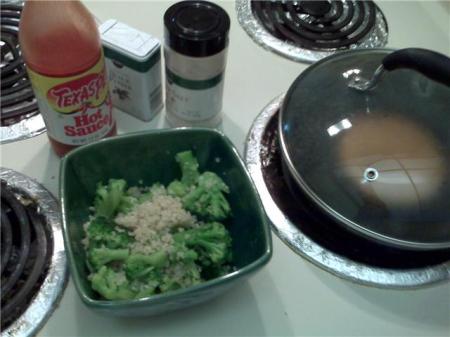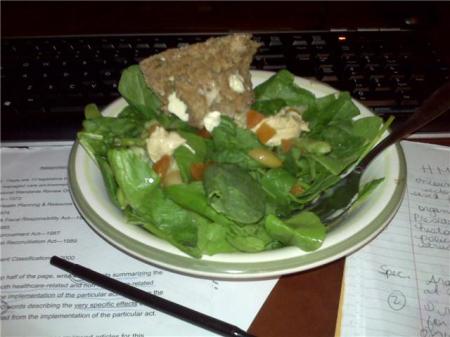Emphasis on the word FRIENDLY!
I was reluctant to post this having witness some ugly comments on blogs in the past, but then I thought about my readers and frequent commenters, and all of you seem lovely, so here it is:
As some of you may know, I am getting my master’s degree in Health Service Administration. My degree centers around health policy, management, finance, trends, etc. In one of my classes, I recently lead a seminar on public health, specifically: Obesity. As many of us know, obesity is a condition of epic proportions in our country. 34% of Americans 20 years and older are obese, and between 13 and 17% of children are obese. Source
Last semester in my Advanced Expository Writing class, I wrote a paper about obesity in America as it relates to health insurance premium costs. If you are unfamiliar with health insurance policy, then you may not know that the amount that you and/or your employer pays for your premium has little to do with you and your health (although there are exceptions), and more to do with the health of everyone else that is insured under the same policy. The concept is called “risk pooling”, and it spreads insurance costs from one patron to all the others.
It is a fact that obesity increases chronic illness, therefor raising health care/insurance costs. The question I raised in my paper was: should a person’s lifestyle choices (obesity, smoking, etc) effect how much he/she pays for health insurance?
In my opinion, the underlying problem with this issue is the lack of preventative medicine and education in our country. Our approach to health is based on the Medical Model which emphasizes diagnosis and treatment. I personally feel the interest of Americans would be better served with the Wellness Model, a holistic approach which focuses on mental, physical, emotional and spiritual wellbeing to prevent disease instead of diagnose it. I am very passionate about this issue, and if, God willing, I go on to get my PhD, my research will be based around prevention and its effects on our healthcare system.
**Below, I have included the paper that I wrote on this topic.
Leave a Comment: What is your opinion on the obesity epidemic in our country? Who is at fault: individuals, the government, the healthcare system? What can be done to solve this issue? Do you believe in preventative medicine?
**Essay:
Shape Up or Pay Out: Should Lifestyle Choices Factor into Health Insurance Premiums?
Topic: Should a person’s lifestyle choices affect how much he pays for health insurance?
Format: Magazine article to educate general public in hopes that they would become more informed on an issue relevant to their own lives.
There is a new administration settling into the White House. In one month this administration has already passed an economic stimulus package with hopes of creating new jobs and igniting a lifeless economy. To stimulate the economy President Obama is working tirelessly, but there is still a dark cloud looming over the head of many Americans, and that is the issue of health insurance. Health care currently costs our nation 17% of our GDP (Gross Domestic Product). That amount is more than any other industrialized nation spends. Our nation also has the highest number of uninsured citizens who are unable to receive adequate care, in part because of our employer based health insurance system. Nearly two thirds of American’s under the age of 65 receive their health insurance through their employers (Stanton), but with the current economic crisis the national unemployment rate has risen to 7.6% (Bureau of Labor Statistics). When employees lose their jobs, they also lose their benefits leaving an increasing number of people without access to health care.
The economic crisis provides Kairos (opportune timing) for economists, government officials, and health professionals alike to discuss and attempt to fix the health care “system.” The problem is that our system is not really a system, but a bunch of different entities entangled in a web of hospitals, insurance companies, government programs, and HMOs. Health care in America needs to be untangled, but changes are unlikely to come out of congress in the near future since the White House is so focused on the economy. If major reforms are going to happen soon, they are going to have to come from private entities.
Many private insurance companies are trying to change the way health insurance premiums are determined. The companies believe not only that a person’s lifestyle choices should be the basis of how much he pays for insurance, but also that this change would lower their costs as well as the cost of private insurance for many Americans.
Conflict arises not only at the quality stasis (questions or issues) level with discussion of whether this change would be good or bad for Americans, but also at the policy stasis level when legislators question the legality of implementing these changes. As a Health Service Administration student, I know that in order to understand this issue you must first know how health insurance works. Therefore, while I will primarily focus on quality and policy questions, I will first touch on conjecture and definition questions to provide an introduction into the argument.
CONJECTURE: What is the Origin? What is the Cause? The Root of the Issue?
The way health care is provided in the US is why healthy citizens pay for the poor choices of others. This is because of: Risk, Risk Pooling, and The Medical Model of Health Care.
Risk
While most Americans receive large group health insurance at a reduced rate through their employers, not all do. Small businesses rarely offer health insurance benefits, and self employed persons usually don’t have those resources available either. In these cases, individuals have the option to purchase private health insurance. Because of ‘risk,’ private health insurance is significantly more expensive than employer based health insurance. Insurance companies determine its premiums by deciding how risky a person is to their company. Risk, therefore, is how much an individual will cost.
I want you to imagine for a moment a large pond with 1000 fish in it. Now imagine that you are one of those fish. What are the chances that a bird is going to catch you from the pond to eat for dinner? One in one thousand. Now imagine that you are the only fish in the whole pond. You better hope that bird already ate dinner because if he’s hungry, you’re on the menu. That’s why large companies pay lower premiums for their employees: there are more fish in the pond to spread the risk onto. More risk surface area allows these employees enjoy a lower premium, and, in most cases, their employer covers a percentage of the cost. These factors cause difficulty for the average, possibly unemployed, American to afford private health insurance.
Risk Pooling
To continue our lesson in Health Insurance 101, we must address a seemingly obvious point: why does health insurance cost so much money? The simple answer: because health care costs money. Okay, but what if a person goes his whole life without ever needing more than a regular routine check up? Good question. What an individual person pays for his premium does not reflect the amount of care he receives; what it does reflect is the amount of care he could potentially receive AND the amount of care that other people covered by the same insurance provider could receive. This is a concept known as risk pooling and is an ordinary practice in the insurance business, emphasis on the word business. Insurers need to make sure they have the funds to cover catastrophic health emergencies without a deficit. This goes back to that fish in the pond analogy. If one fish gets mauled by the bird and needs extensive scale reconstructive surgery, the insurance company needs to make sure that it has collected enough money from the other fish’s premiums to cover the extraordinary cost. Therefore all of the healthy fish help to pay for the injured fish’s care.
The Medical Model
In the current health care system, the norm is that lifestyle choices do not factor in deciding the cost of a health insurance premium. In fact, our current health care system doesn’t promote healthy lifestyle choices at all. In America we follow the Medical Model of health care. The Medical Model focuses on the eradication of illness through diagnosis and treatment, so instead of preventing illness we treat it as it arises. In contrast, there is another model, Wellness Model of Health Care, which takes a more holistic approach medicine. The four aspects of the Wellness Model are: physical health, emotional health, mental health, and spiritual health and is used primarily by Doctors of Osteopathy and Chiropractors. It promotes preventative medicine, which is preventing illness from occurring in the first place, by focusing on leading a healthy, well balanced lifestyle. Prevention is the focus of including lifestyle choices in insurance premiums, but it is for more financial reasons than holistic health reasons.
Before we go on, let me be clear about one thing: horrible, awful, terrible, devastating illness and accidents happen to healthy people who do everything right all of the time. For the purposes of this article I would like you to put those cases out of your mind and focus on the health problems that stem from the lifestyle a person leads.
Let’s go back to the fish pond for a moment. Pretend that there are certain types of algae that lessen the chances of the fish getting attacked by birds. Now take it a step further and pretend that if the fish swim two laps around the pond a day they would have an even lesser chance of being attacked. Remember the fish that was attacked by a bird? What if he refused both to eat the special preventative algae and to swim two laps around the pond? Should the other fish have to pay for the poor lifestyle choices this one fish? In our current system, the answer is yes. In health insurance, premium rates are based on a group of people—remember risk pooling?—so the lifestyle choices of one person essentially determine how much another person’s premium will be.
The answers to these conjecture questions are statements of fact, which is why conjecture is not the stasis level at which the issue is being argued.
DEFINITION: What is it? What are its Parts?
While there could be some debate about the definition of lifestyle choices and which ones are worse than others, most health professionals agree on the main choices that are affecting health of individuals. The consensus is that smoking, heavy drinking, diet, and activity level are the lifestyle choices that worsen health and increase insurance premiums (Stanciole 628-644).
Smoking poses more risk to a person than just bad breath. It can also lead to lung cancer, high blood pressure, high cholesterol, stomach ulcers, and heart disease; and care for these conditions is expensive. $96.7 billion is the annual cost of health care related to smoking. Smoking is a lifestyle choice that is setting precedent for the other choices because insurance companies and employers are currently permitted to charge smokers up to 40% more for their premiums (Smith).
Heavy chronic drinking can lead to numerous health problems including, but not limited to: cirrhosis of the liver, pancreatitis, various cancers, and high blood pressure. Excessive alcohol consumption causes $22.5 billion in medical expenses which are then spread to other consumers of health insurance (Health Care Costs of Alcohol).
Poor diet choices on a regular basis paired with a sedentary lifestyle can cause numerous health problems on many physical, mental, and emotional levels, the most widespread being obesity. Nearly 2 out of 3 American are either overweight or obese. Obesity currently costs America $61 billion in direct medical costs and $56 billion in indirect costs. The cost of health care for an obese person is 36% higher than an individual at a healthy weight, and the cost of medication is 77% higher (Carmona).
While negative lifestyle choices (for our purposes, the term “lifestyle choices” represents: smoking, alcohol consumption, activity level, and diet) increase costs, positive lifestyle choices have been proven to lower the cost of health care. If just 10% of adults began walking on a regular basis it would save $5.6 billion in heart disease costs, and if an overweight individual sustained a 10% weight loss he could reduce his lifetime medical costs up to $5,300 (Carmona). It is agreed upon that positive choices lower costs and negative choices increase costs. Therefore, definition is not where this issue is being debated.
QUALITY: Is it Better or Worse than Something Else?
The high cost of health care is hitting the middle class more than any other socioeconomic group. Low income individuals are generally covered by government programs such as Medicaid and SCHIP (State Children’s Health Insurance Program), and upper class individuals either hold jobs that provide adequate coverage or can afford to purchase it on their own. Because of this, the argument in the stasis level quality is that of affordability. Some argue that increasing financial accountability for lifestyle choices will force individuals to make better choices, therefore lowering their insurance costs and improving their health. Others think that doing so will make insurance even more unaffordable to the unhealthy and lessen their chances of receiving quality care (Appleby).
David Cutler, a Harvard economist, estimated at least 3 million more U.S. residents will be without coverage if medical costs rise 5% above inflation for each of the next four years. Americans already spend approximately 23% of their annual income oh health insurance (Appleby).
Rewards for positive lifestyle choices and/or repercussions for negative ones would either help one group of people or hurt another. Taking risk pooling into consideration, charging more for poor lifestyle choices would decrease the cost of insurance for healthy individuals who make positive choices to improve their health. If the goal is to lower the cost of insurance for everyone, this policy will only succeed if individuals decide to make behavioral changes and improve their lifestyle choices. The solution to this level of the argument can only be answered by the effort of individuals to lead a healthier lifestyle.
POLICY: What actions should be taken?
The cost of health care in the United States is outrageous; doctors, administrators, government officials, and the general population can all agree upon this. It is also the consensus that certain lifestyle choices of an individual increase the amount of care needed therefore increasing the cost of health insurance for everyone. Additionally, people are in accord that an individual adopting a healthier lifestyle is a positive change for the nation as a whole, though there is some disagreement on how this should be accomplished. These points segue into the big question is: Is it lawful to allow insurance companies to charge individuals more for health insurance if they choose to engage in behaviors that are detrimental to their health, therefore costing the insurance company more money? Some say yes, while others say no.
“Ex Ante Moral Hazard” is an insurance term that simply represents the decline in preventative behavior when a person is aware he has insurance. In health care, this reflects the, “I don’t need to take care of myself; I have insurance, so if I get sick, I’ll just go to the doctor” attitude (Stanciole 628-644). This attitude results in more care and high cost. Since cost is spread through risk pooling, it is unfair to force “healthy” to pay for the superfluous care of others when it could be prevented by eating a few vegetables and exercising for a few minutes a day. Thus, holding individuals more accountable for their lifestyle choices will decrease this moral hazard and reduce the cost of health care.
A few insurance companies have tried to regulate lifestyle choices. In theory, this regulation can be done in two ways. The first is to reward individuals for making healthy lifestyle choices, and the second is to penalize those who don’t. Current legislation prevents companies from doing the latter, but some have tried to create incentive for people to adopt and maintain healthy lifestyle choices.
In 2007, Lifespring Health created the first loyalty rewards program in the health care sector. Their program lets individual members earn points redeemable to pay for health services, prescriptions, elective surgeries, gym memberships, and wellness products. Members can also put the points into a Health Savings Account or use them toward health insurance premiums (Biotech 412).
Prudential is another company jumping on the bandwagon by slashing premiums up to 75% if customers agree to have their lifestyle choices monitored. They keep tabs on diet and exercise regimens of their customers and are considering an extension of the program to monitor alcohol consumption. Currently, PruHealth has over 140,000 people participating in their healthy lifestyle reward program in America, and even more overseas. In the UK, Prudential partnered with a grocery chain to originate its PruHealth program. In this case, the program allows insurance customers to accumulate points for things such as purchasing fruit, walking their dog, abstaining from smoking, and going to the gym. With the point system, customers could essentially earn a discount of 100% off their premium making their coverage free (Birmingham Post, 19).
In the wake of the economic recession, many insurers think it would be beneficial to market a high deductible plan that significantly reduces premiums for the customer. One such company is United Healthcare. They launched their Vital Measures plan which encourages customers to lower their out-of-pocket costs by improving their health. While opponents see these discounts as potential discrimination, proponents see it as good for business. United Healthcare’s Tom Beauregard explains that, “This is the next frontier for how we manage costs because you’re not going to do it through increased cost sharing” (Smerd).
Those on the opposing side of the issue are concerned with cherries and lemons and no, I’m not referring to fruit. In health insurance jargon there are two types of people: cherries and lemons; cherries are healthy people and lemons are people with history of illness (Hoong). For some it is a priority to ensure health insurance companies don’t go “cherry-picking” and only insure healthy customers. When companies do this, they collect premiums from cherries for years and rarely have to shell out for medical expenses. While it may seem like a good business strategy (and our capitalism and lack of universal care does makes healthcare a business), it poses a problem for persons who have a prior illness, say cancer or Type I Diabetes, to obtain decent coverage.
The opposition is also concerned with the legality of monitoring lifestyle choices as it pertains to freedom of choice and privacy. Two pieces of legislation provide strict guidelines for any and all wellness programs; these laws are not only preventing more insurance companies from creating lifestyle reward programs, but also preventing employers from adopting the current plans to provide for their employees. In 1996 the Federal Health Insurance Portability and Accountability Act (HIPPA) was passed, and part of this law bans different rates for health coverage due to a patient’s right to privacy. The other piece, The Americans with Disabilities Act, forbids asking probing health questions (Robbins). Also, the Office of Finance and Insurance Regulation, as instructed by the Senate, allows insurance companies to set premium rates based on sex, age, residence, disability, marital status and occupation pending approval (Greene 7).
Some also feel that it is a moral issue. Dr. Max Pemberton considers it to be “morally reprehensible” to withhold services from people simply because of the lifestyle choice they make, even though he does address that the patients should work to change their lifestyles (Pemberton 25). Dr. Pemberton is one of the few in his field that oppose factoring lifestyle choices, but many “fat” consumers of health care are outraged.
The “Big Fat Blog” is a forum for overweight individuals to articulate their feelings toward a thin-obsessed society. Paul McAleer, the blog author, writes to bring awareness to size related discrimination. A recent post explaining how body mass index (BMI) now dictates how much an individual pays for health insurance recently caused numerous concerned posts. Clarian Health, a healthcare system based in Indianapolis, Indiana, enacted a new policy that will take 10 dollars out of an overweight person’s paycheck every month. While discussing this topic, McAleer had this to say, “If your BMI is over 30, it’s going to cost you $10 per paycheck. This is not a joke. This is legal. This is bullshit.” Comments showed shock and expressed concern for the HIPPA law violation this policy causes (McAleer).
CONCLUSION: Where do we go from here?
The economic crisis will not disappear overnight, and neither will the rising costs of health care. Many solutions to rising costs have been proposed including: universal health care; health care vouchers; and removal of employer based health care just to name a few. In the mean time, insurance companies hope to provide and receive financial relief by setting individual rates based on lifestyle choices. Smoking, heavy drinking, activity level, and diet are the agreed upon choices that directly raise health care costs. The argument is based around issues of quality and policy. Does enacting these policies hurt more people than they help or help more people than they hurt? Are these policies legal? Moral? Just?
In order to resolve this argument, policy makers need to focus solely on one stasis level. If people keep arguing at the policy level they will keep talking past each other since there is not agreement in the quality level. In the quality level, more research needs to be done. Researchers need to determine if rewarding good lifestyle choices incites change. They need to determine if the benefits for some outweigh the repercussions for others.
A commonplace in American culture is ‘fairness,’ or justice for all. The question is: Who would be treated unfairly by enacting this policy (or not enacting it)? Would people who make unhealthy choices be treated unfairly since they should have the right to make their own health related decisions? Or would people who make healthy choices be treated unfairly since they are acquiring added health care cost for other’s decisions? When looking at the topoi (common topic) question of degree, we must decide treating one group unfairly is better or worse than the alternative. When these questions can be answered is when policy makers can enact effective legislation on this matter. Until then, both policy makers and the general public will continue to disagree on whether lifestyle choices should be allowed to dictate how much an individual pays for health insurance.
Works Cited:
Appleby, Julie. “Health Insurance Premiums Crash Down on Middle Class.” USA Today. 16 Mar. 2004. Health and Behavior. 17 February 2009 <http://www.usatoday.com/news/health/2004-03-16-healthcost_x.htm>
Bureau of Labor Statistics. “Employee Situation Summary.” United States Department of Labor. 6 Feb. 2009. 17 February 2009. <http://www.bls.gov/news.release/empsit.nr0.htm>
Carmona, Jeffery. “The Obesity Crisis In America.” Office of the Surgeon General. 16 July 2003. 17 February 2009 <http://www.surgeongeneral.gov/news/testimony/obesity07162003.htm>
Greene, Jay. “House, Senate to Debate High-Risk pool, rate for Blues.” Crain’s Detroit Business 5 May. 2008, News: 7. Academic. LEXIS-NEXIS. UCF Library. 15 February 2009 <http://www.lexisnexis.com/us>.
“Health Care Costs of Alcohol.” The Marin Institute. 2006. 17 February 2009 <http://www.marininstitute.org/alcohol_policy/health_care_costs.htm>
Hoong, Chua Mui. “Regulate Private Health Insurers to Eliminate “Cherry-Picking”.” The Straits Times 15 Feb. 2008, 1280 words. Academic. LEXIS-NEXIS. UCF Library. 15 February 2009 <http://www.lexisnexis.com/us>.
Pemberton, Max. “It’s wrong to abuse the obese, says Max Pemberton, but it’s right to make them diet. Trust me I’m a junior doctor.” Source 25 Feb. 2008, Health: 25. Academic. LEXIS-NEXIS. UCF Library. 15 February 2009 <http://www.lexisnexis.com/us >.
“Pru and Sainsbury join to promote healthy eating; INSURANCE.” Birmingham Post 5 Sept. 2007 Date, Business: 19. Academic. LEXIS-NEXIS. UCF Library. 15 February 2009 < http://www.lexisnexis.com/us>.
McAleer, Paul. “Clarian Health, Others Will Dock Your Paycheck If You’re Fat.” Big Fat Blog. 8 Aug. 2007. 17 February 2009 <http://www.bigfatblog.com>
Robbins, Mclean. ” Benefits beat-down: Clarian’s big-stick wellness approach gets mixed reviews from health, benefits experts.” Employee Benefits News 15 Sept. 2007, News: 1059 words. Academic. LEXIS-NEXIS. UCF Library. 15 February 2009 <http://www.lexisnexis.com/us>.
Smerd, Jeremy. “High-Deductible Plans Could be the ‘Next Frontier’.” Workforce Management 3 Nov. 2008, Business: 594 words. Academic. LEXIS-NEXIS. UCF Library. 15 February 2009 <http://www.lexisnexis.com/us>.
Smith, Hilary. “High Cost of Smoking.” MSN Money Central.. 3 Sept. 2008. 17 February 2009 <http://articles.moneycentral.msn.com/Insurance/InsureYourHealth/HighCostOfSmoking>
Stanciole, Anderson. “Health Insurance and Lifestyle Choices: Identifying Ex Ante Moral Hazard in the US Market.” The Geneva Papers. 2008. pg 628-644. 17 February 2009. <http://www.palgrave-journals.com/gpp/journal/v33/n4/abs/gpp200827a.html>
Stanton, Mark W. “Employer-Sponsored Health Insurance: Trends in Cost and Access.” Research in Action Issue 17. Agency for Healthcare Research and Quality, Rockville, MD. AHRQ Publication No. 04-0085. September 2004. 17 February, 2009 <http://www.ahrq.gov/research/empspria/empspria.htm>
WELLNESS; Lifespring Health Offers Free Cash-Back Rewards Program and Loyalty Credit Card to Offset Rising Healthcare Costs.” Biotech Business Week 27 Aug. 2007, Expanded Reporting: 412. Academic. LEXIS-NEXIS. UCF Library. 15 February 2009 <http://www.lexisnexis.com/us>.




























